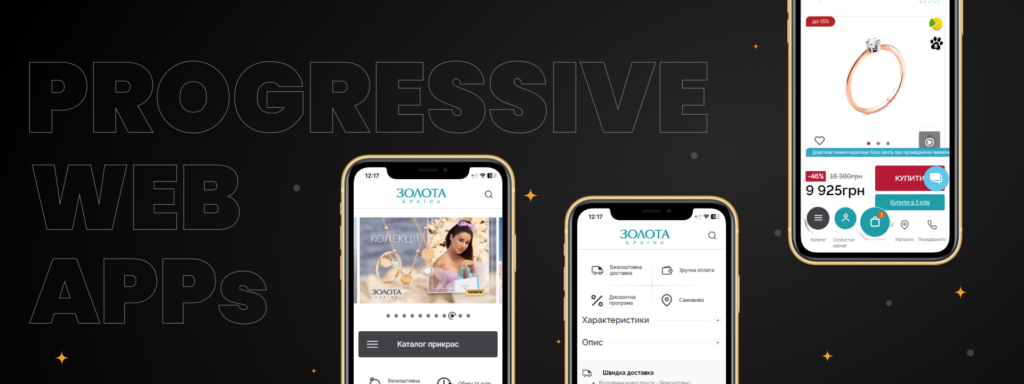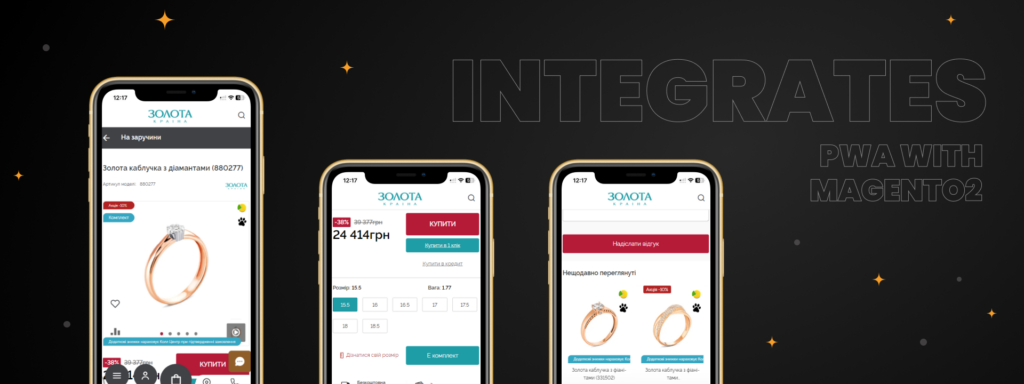In 2020 retail e-commerce sales grew by 27.5% worldwide, and sales are still increasing. How do you stay competitive in this market? Owners of online stores already have a lot on their plate.
It’s so competitive that even milliseconds of loading time may tip the scales in favor of your competitor. A study of mobile site data from European and US retail brands showed that with a change in a load time as small as 0.1s, conversion rates grew by 8%.
Luckily, there’s a technology that can improve the speed of your e-commerce on multiple platforms: progressive web applications (PWAs). Let’s explore more about what PWA is and what benefits it offers you and your customers.
What are progressive web apps, and how can they benefit your business?

PWAs are a type of application written in markup or programming language such as HTML, CSS, JavaScript, or WebAssembly, that operates in a browser. But it works across platforms, including web, desktop, and mobile as well as operating systems, delivering an app-like user experience.
This technology has been gaining popularity; 17% of e-commerce companies already use or plan to introduce progressive web apps in 2021.
How PWAs benefit your customers
PWAs open up opportunities that can improve your users’ experience and satisfaction.
Since 2017, the proportion of retail e-commerce on mobile rose from 58.9% to an expected 72.9% by the end of 2021. So perhaps one of the biggest benefits of PWAs is that they allow your customers to access your store on their mobile phones with the convenience of a native mobile app.
Multiplatform support. A PWA allows you to deploy your e-commerce store to any device with any screen size and any operating system.
Progressive web apps are a solid alternative to native iOS and Android apps, as they act like native apps yet have a website’s availability. They don’t require installation from the App Store or Google Store. Users can simply create an icon from the browser on their home screen. The shortcut icon will then show up on their phone screen, just like any other application.
Performance and storage. PWAs use web caching, making them fast on any platform. They smoothly transition between pages, run animations, and scroll within pages. When installed on a phone, they require less storage than native apps because they’re essentially just webpages.
Engaging experience. PWAs offer a sleek user experience because they look like an app and provide app-like interactions. They can also send push notifications, track geo-location, and interact with the device as native apps do.
Offline support. Owing to caching, progressive web apps will still work if your users have a poor internet connection or none at all.
Always up-to-date. Because a PWA is essentially a webpage, your users always see the latest version and don’t need to download any updates, like they do for apps.
All of the above perks enhance your users’ experience and conversion rates, which can ultimately translate into sales. In addition, your business gains direct cost benefits when you implement a PWA.
How PWAs benefit business
Cost-effective. Without a PWA, if you want a truly cross-platform online store, you would need to invest in a website, desktop app, and either a mobile-responsive website or native iOS and Android apps. Each platform requires your team to have specific skills for both development and maintenance. Alternatively, you can choose a PWA, which only requires web-development skills. You can build one PWA front end that works everywhere.
Flexibility. PWA software takes advantage of headless technology. Headless means that your website’s front end is separate from the back end. This means fewer hidden interdependencies in the code, so it is easier to change one thing without breaking another. This allows more creativity while still getting your products to market quickly.
Easy to promote. Progressive web apps are linkable, so your users can easily share them. They’re also visible to search engines, allowing you to promote them with usual SEO efforts.
Both new businesses that are just developing their online presence and established companies can reap these benefits. Let’s look at the options for an existing e-commerce store that uses Magento for PWA integration.
PWA integration for Magento 2
If you use Magento as your e-commerce platform and have already made the most out of Magento bug fixing services, you can easily integrate a PWA into your existing website. Magento used to offer a Magento theme component for customers’ front end. It was deeply integrated into Magento core code, and therefore it was hard to customize.
With Magento 2, Adobe developers introduced a new version with a more flexible solution: the Magento storefront. The Magento storefront is a progressive web app built using Magento 2 PWA Studio tools, which are tools and libraries that help with PWA integration.
A Magento 2 PWA storefront works with the headless Magento back end and middle-layer support. The application is composed of modules, offering greater flexibility. The modules are LEGO-like pieces and can be swapped or even removed depending on what you want the final result to look like.
Alternatively, Magento storefront, you can use any other open-source or commercial storefront software that satisfies your needs and integrate it with the headless Magento back end.
Most importantly, PWA integration allows you to create a mobile app for Magento without any extra effort of creating an independent mobile app.
Let’s have a look at how we implemented a fast cross-platform online store for one of our clients, a jewelry brand, by integrating a PWA with Magento 2.
Case study: Jewelry brand integrates PWA with Magento 2
Due to the end of support of Magento 1, an e-commerce jewelry brand got in touch with our team at IT Delight. The client needed assistance with migration to Magento 2. During analysis of the migration plan, we identified an opportunity for the brand to go multiplatform with a PWA, which ultimately made them sign off the project!

The goal
Our goal was to perform the migration from Magento1 to Magento2 efficiently and create a PWA application for the brand’s online store.
The challenges
The client was an existing and well-established business. It had accumulated several business practices that our solution had to comply with. We had to consider existing tools for inventory management, customer relationship management, and marketing. Getting these to work harmoniously across platforms was the biggest challenge.
The solution
First, we successfully managed the transition to Magento 2 development. For the front end of our PWA, we chose the open-source Vue Storefront from Divante because, at that time, it looked more complete compared to the Magento storefront.
- Inventory management system. First, we integrated our customer’s back end with 1C software, the program they used for accounting and inventory management. As a merchant of physical goods, the company developed a stock-keeping (SKU) unit that they used for item tracking, inventory, and sales management. We developed a system that obeyed all the SKU rules and integrated it with both the Magento back end and the PWA front end. On the one hand, this allowed the business to manage stock effectively, and on the other hand, let users see items available for sale.
- Customer management system. As this brand had been on the market for some time, it had built up a customer loyalty program. Our team implemented a special price scheme for certain existing and future customers of the store. Thus, the store loyalty program persisted, and customers could benefit from any discounts they accumulated.
- Custom purchases. Jewelry sales are special because jewelry often comes in sets. Earrings are often more charming when they come with a matching necklace. To motivate customers to buy sets or even collections, the brand decided to offer special discounts for these types of purchases. Our specialists developed a new feature for the online store that enabled discounts for customers who purchase a set or collection.
- Content Management. One of the most critical assets to keep and reuse was the brand’s existing marketing content because it impacts the store’s online ranking. Because a lot of their content had links to the Magento website itself, our team had to create a parser, which prepared blocks that reused the links in Vue Storefront UI.
- Check out. The customer decided to change their platform for payment processing to Fondy. Because Fondy didn’t have a module for the Vue Storefront out of the box, we integrated Fondy with Magento and our PWA manually.
Several of the new store’s features required revamping the checkout page. We created a new flexible checkout that lets users confirm their order, including their size; choose the packaging and delivery method; see any discounts applied; and most importantly, pay online or even set up installment payments.
Outcomes
As a result of PWA integration and migration to Magento 2, the customer now enjoys the benefits of a lightweight, flexible, and easy-to-use solution for its online store.
An up-to-date back end and integration of the PWA front end made our client’s online store fast. This helped the business stay competitive, as it improved the user experience and search ranking.
The store’s front-end solution works across platforms, including mobile. Expanding to mobile helped the brand reach a larger audience. The user-friendly UI of the PWA looks like a native app, which engages the brand’s customers more strongly.
The integration supports all the business’s pre-existing processes. This allowed the company to maintain its own inventory management, offer customer loyalty programs, and provide special discounts.
Finally, the solution we developed is easy to maintain. Suppose the business’s managers need to update or add new information for the store. In that case, they need only to do it once in the Magento Admin panel, and all the changes will apply automatically across platforms without the burden of making changes for each platform.
Enhance your Magento E-Commerce with PWA
It doesn’t matter if you’re a new business or an existing company. If you’re looking to improve your customers’ experience, we can help! Contact us at IT Delight to create a mobile app for Magento, go cross-platform, and make your online store faster.
Magento and Magento 2 development have been our focus for almost a decade. Our certified professionals have extensive experience in creating and customizing Magento e-commerce sites. Our experts will provide a high-quality solution that aligns with your business goals, timeline, and your budget.
